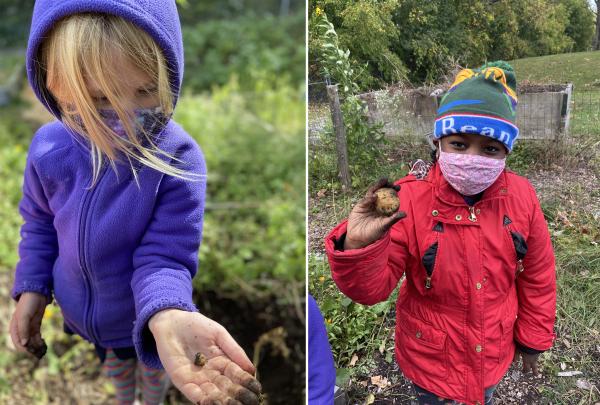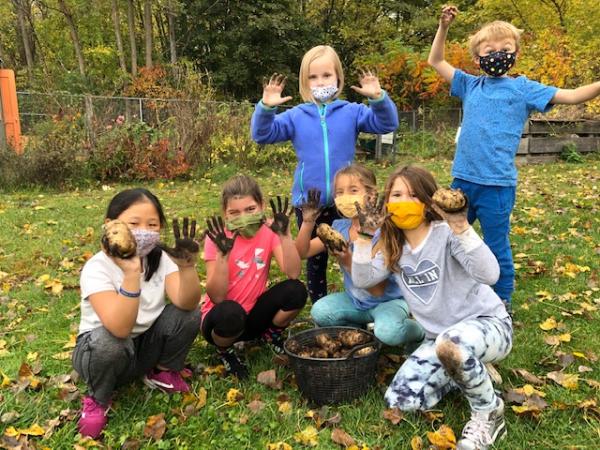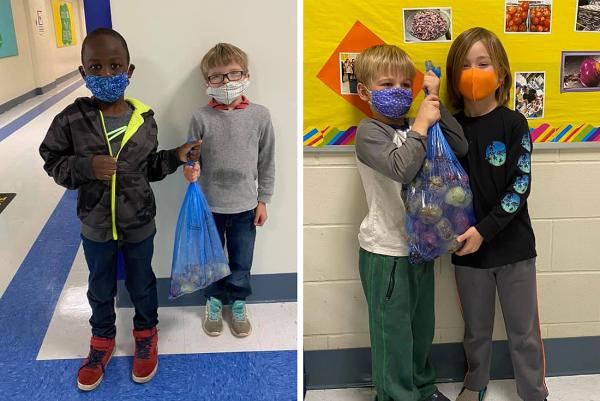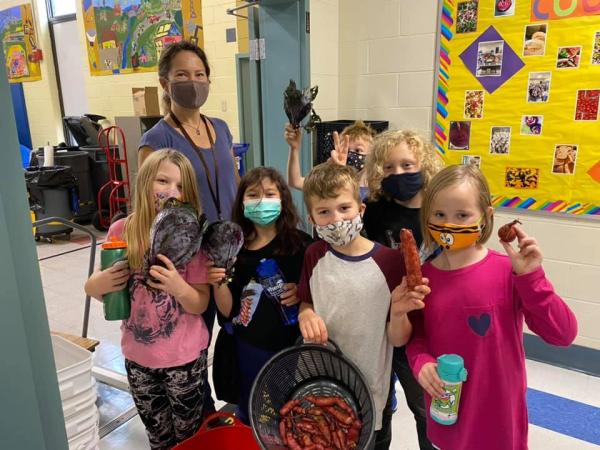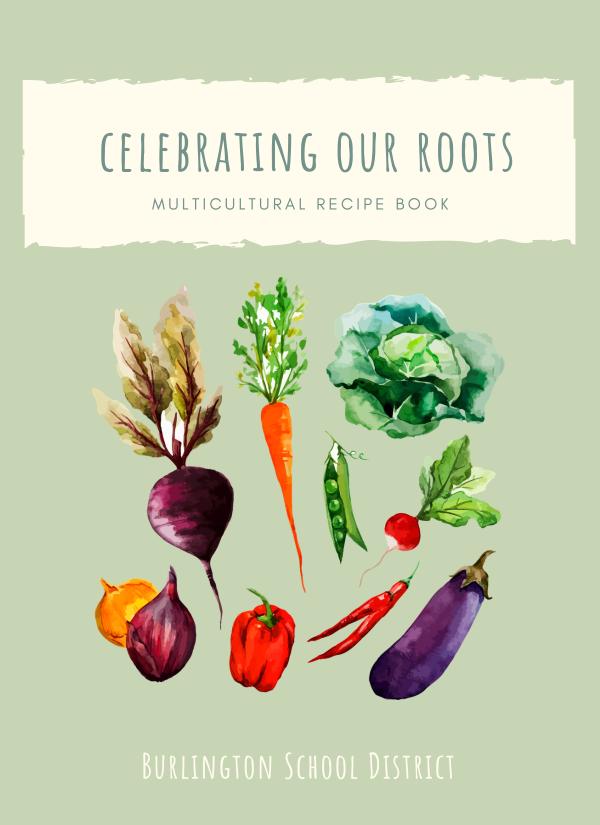How may I purchase/make a donation to get one of these fabulous cookbooks?
Thank you.
Celebrating Our Roots: Amplifying Who We Are
Aziza Malik is a teacher who continually asks herself, How can we, as a community, create lasting opportunities for our students to develop a deeper relationship to their community, the land, one another, and themselves? Last fall, her work around celebrating the district’s first Indigenous People’s Day was highlighted in our blog, Threading the Past into the Future: Infusing Indigenous Perspective in our Curriculum. Not surprisingly, that work became a springboard for another community-wide project that is centered on surfacing the food traditions of traditionally underrepresented students and populations within Burlington--the Celebrating Our Roots project.
In the midst of the COVID pandemic, the Celebrating Our Roots recipe book emerged from the school gardens at Champlain Elementary School in the Burlington School District (BSD). As described within its pages, Celebrating Our Roots was “created in efforts to bring more appreciation and cultural awareness into Burlington's diverse school system. This book contains accessible recipes from the home countries of many BSD families. While there is so much to explore within these cultural backgrounds, this serves to be an introduction of other cultures for younger students, and to open them to understanding their surroundings and the world going forward in their education.” It contains recipes and information from Abenaki traditions as well as from some of the most recent immigrants to Vermont. It weaves together family, community, gardening, cooking, and the curriculum. The beautiful cookbook was a collaborative project with members of Champlain Elementary’s Outdoor Committee and the University of Vermont.
In a recent conversation with Aziza, she shared about the seeds and hopes of this work-in-progress.
Where did the inspiration for Celebrating Our Roots come from?
One of the moments that inspired me was when we made some chai together in our classroom. I was sharing some of my culture--how my family makes chai tea. This student of mine, who’s Somali-Bantu, said, “My family makes it exactly the same way!” The next day he came in with little bags of Lipton tea. It was this very sweet, wonderful connection that we had. He actually brought the ingredients in to make the tea! He was so excited and proud of it. I wanted to find a way for every kid to be able to make and share something that they really love--to proudly be able to say, "This is of me"--and to have that project really reflect all the kids at our school.
How did that spark develop into a school-wide project?
During our land acknowledgement project in the fall of 2019, we had the opportunity to learn about plants that are culturally significant to the Abenaki people from Judy Dow (a local educator, activist and Abenaki artist). As the Outdoor Committee began to plan for the next growing season in our school garden, we knew that we wanted to incorporate some of these Abenaki crops. Then we thought, “Wouldn’t it be amazing to have everybody from first peoples to our newest Americans represented in the crops we grow?” From that seed, a fuller project grew that included gardening, connecting with community partners to learn about the crops and the related food traditions, and developing a cookbook/educational resource that would expand the project beyond our school and district.
Tell us more about the Outdoor Committee.
The Outdoor Committee is one of many committees at the school. This group works on projects related to the school grounds, school gardens, and other place-based and outdoor initiatives. The committee was first formed about 5 years ago when a team from Champlain Elementary attended Vermont FEED's Northeast Farm to School Institute [VT FEED is a partnership program of Shelburne Farms and NOFA-VT]. This was the first chance we had had to sit down as a team to think about how we wanted to use the school garden. We came up with a plan to shift from a system of individual classes adopting individual plots (which had never really worked very well), to more collectively sharing the garden space. That re-organization really changed how we used the garden and our farm to school curriculum. It immediately created more entry points for teachers and students and increased participation across the school. It was an important foundation of this project. Also, committee members typically include several teachers and staff, our garden education coordinator, parents, and the school chef. Last year, while we were developing Celebrating Our Roots, a couple of committee parents were directly connected to New Farms for New Americans and NOFA-VT--organizations that could support our garden-based work.
Like everything that was planned last winter and envisioned for the spring, your project was impacted by COVID-19, which required new precautions and some distance learning. What was your original vision for the project? How did you adapt your plan?
Our vision was for all of this work to be done in partnership with the students and the adults in our community. We thought we would start in our garden education classes by exploring the question What are our food traditions? We imagined students participating in every step of the process--as gardeners, researchers, writers, cooks and eaters--with many opportunities for students and teachers at all grade levels to engage.
During the winter, we put in a proposal to UVM’s NR 206 students, who we often partner with, to have them help us to research crops that would represent the school district’s full diversity and be viable in Vermont. They would then develop the garden plan to incorporate the new crops, and create a template for the cookbook based on Harvest of the Month. This resource, which we’ve used a lot with teachers, students, and families, contains information about a crop, including its cultural significance, as well as activities and a recipe. We thought, this is an awesome model--can we develop something similar? We wanted the UVM students to create the project framework, and then we planned on working with our school population and local community to crowdsource the recipes, seeds, and the stories to go with them.
Once COVID hit, the student and community parts of the project were put on hold. However, the NR 206 students kept moving forward and ended up creating the framework and the content of the recipe book. So now we have our base document in place. It doesn’t quite reflect the community input that we had wanted, but it’s a great starting point.
We want to bring student voice back into the work. This fall, students have been able to be in the garden again and have harvested the new crops that were planted last spring. Due to COVID, though, we’re still not able to do any cooking with students; we’re limited to sampling only raw and fresh vegetables. But our school chef is now available to partner with us again. So that’s our next step--working with her so that she can use what we harvest to prepare some of the recipes for students to taste test. Since the UVM students really researched and chose the recipes for the book, we need to start to test those recipes to see if they are truly appropriate for our region, classrooms, and students. Are these crops that grow in Vermont? Does the recipe work for the classroom, with students as cooks? What are the alternatives for recipes with major allergens? Will the recipes challenge student palates and be appealing?
My hope now is that we can truly roll out the project this spring. We’ve now got our systems in place for being safe at school and we can start adding these kinds of programs back in. We’ll figure out how to safely gather ideas for recipes and plants with kids, and for sure they'll be able to plant and work in the garden. My hope is that we’ll figure out some way to also do cooking at school as well.
What seems to make projects successful and sustainable is when everybody really feels that they are a part of it. That’s what we’re really trying to do with Celebrating Our Roots. We’re removing barriers to help people to participate and creating many options for all students and teachers to engage. It’s not about one teacher and one classroom. It becomes about the school as a whole or even the district as a whole. It’s not my project, it’s the school’s project. It’s unifying.
Comments
What wonderful work really connecting to the land and the community. Lucky kids!


